
Jim Dau
Northwest Alaska, from Kotzebue Sound to the headwaters of the Kobuk River, is approximately the size of Indiana. It is mostly roadless wildlands dotted by eleven villages that are located on the coast or along the major rivers.
The Red Dog Mine with its associated road and port site is the only large resource development project in the region, leaving most of the area in a natural state. Except for Red Dog, the relatively small rural communities, and the numerous but even smaller individual camps along the coasts and rivers, there is no obvious distinction between what is designated as formal wilderness and what is not. Federal lands in the form of parks, preserves, wilderness areas, a monument, and a national wildlife refuge comprise the majority of formal land designations in the region.
Wilderness areas include the Selawik Wilderness, Noatak Wilderness, Kobuk Valley Wilderness, and Gates of the Arctic Wilderness. Given the lack of habitat demarcation between wilderness areas and other areas, it is not surprising that you would be hard pressed to find any lifelong residents of northwest Alaska who could tell you where the formal wilderness areas are, or how they differ in management from other federal lands.
While most people in the region are aware that park units and other land designations exist, few are aware that formal wilderness areas occur here as well. This collective inability to identify the boundaries of wilderness areas demonstrates the intact nature of the land and local residents’ strong cultural ties to it, with the only visible boundaries being on paper (Figure 2).
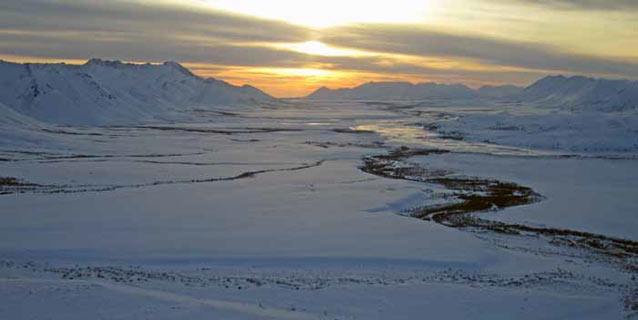
Jim Dau
The formal designation of wilderness areas in northwest Alaska contributes to sustaining an ecosystem that is predicated on an expansive area of natural habitat that is not fragmented by human development.
The nondesignated wilderness areas that adjoin formal wilderness add significantly to the benefits produced by the latter. The relatively small human disturbances in areas adjacent to designated wilderness are mitigated in part by the extensive intact ecosystem that stretches from the Chukchi Sea across the entire Brooks Range.
While all species present in northwest Alaska benefit from large areas of undisturbed habitat, it is critical to highly valued cultural and ecological keystone species like caribou, Dall sheep, grizzly bears, wolves, and wolverines, in particular (Figure 3).

USFWS / Tina Moran
Most people born in the region trace their ancestry back to people living essentially in the same countryside that remains today (including those areas that are now designated wilderness) and a few can trace their own birth, or that of their parents, back to a dwelling located in areas currently designated as wilderness. Being born and raised in wilderness was definitely not a consideration during the development of the Wilderness Act—which by definition is a place where people are visitors and do not remain.
Of course, for Arctic Indigenous populations whose entire history and culture is defined by living in wilderness (whether formally designated or not), the wilderness concept is a western construct that is foreign to them. Much of the local traditions, folklore, notable landmarks, and family histories are associated with the country these wilderness areas encompass (Figure 4).

Jim Dau
Most Americans think about formal wilderness as areas that are representative of natural ecological spaces where nature is allowed to carry on substantially free from human interference and where people are only occasional visitors. Specifically, the main principle of most designated wilderness is for nonconsumptive purposes where only photos are taken and footprints are left.
While designated wilderness areas found in northwest Alaska definitely have the ecological traits represented by traditional wilderness areas, there remain significant differences that set these areas apart from other wilderness areas in the Lower 48 and even those portions of Alaska where the 1980 Alaska National Interest Land Claims Act (ANILCA) legislation does not apply.
The most distinct difference is that these areas are treasured by local residents not for their wilderness character per se but for their economic contributions by providing food and income through hunting, fishing, fur production, and other traditional activities. This enables local people to continue their culture of living off the land and allows many to avoid having to move to distant urban centers to completely join the cash economy (Figure 5).
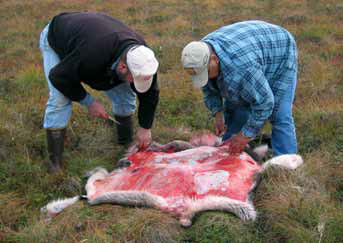
USFWS / Susan Georgette
The beauty of land from a local perspective is anchored in its ability to sustain local culture through the production of high-quality food and fur. The latter can be used to make warm, functional clothing that can be as much art as utilitarian garment, or sold to produce income. The former helps define a people who are first and foremost a hunting culture.
Continuing a way of life based on wild meat consumption is distinct from cultures based on domestic livestock in very qualitative ways. Most of the negatives surrounding western meat production and consumption are minimal or completely reversed to become positives. For example, while petroleum products are used in transportation to secure food and other resources from the country, they are not used to grow or produce them, an important distinction from most domestic food production that has a large carbon and aquifer-depleting footprint attached.
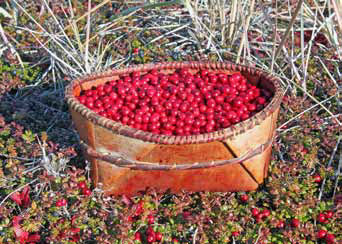
Martha Whiting
Other benefits from eating off the land include: plant and animal food species that are not genetically modified organisms; the production of meat is not industrialized with all the negative inputs and processes associated with this; the disposal of animal waste is not a negative issue and, in fact, provides natural fertilizer for the system. Most importantly the meat and other food items gathered in wilderness areas are very healthy based on their own nutritional merits and even more so in comparison to domesticated meat that studies show contribute to heart disease and other health issues (Figure 6). The health and cultural benefits of going out into the country with family and friends to obtain these resources also contributes greatly to the quality of life for residents in the region.

USFWS / Susan Georgette
Of course while food and fur production is demonstrably the most valued contribution that wilderness provides to the regional way of life, other benefits of wilderness are also present. These landscapes provide local people with a sense of freedom, a tie to their ancestors, cultural expression, and spiritual renewal (Whiting 2004).
One of the most notable cultural contributions provided by utilizing the backcountry of northwest Alaska is the egalitarian effect it has on societal standing. The land affords greater privileges and rewards to those who earn it through experience, skill, and conditioning regardless of their net worth or formal resume. Technology and money can only compensate for a lack in any of these areas to a very limited degree. This situation allows for those that are experts at wilderness living and who may not necessarily participate in large part in western institutions to achieve a high level of societal status and self-worth. The greatest respect in Iñupiaq society is still reserved for those that are successful hunters and providers and that are knowledgeable about living and surviving off the land (Figure 7).
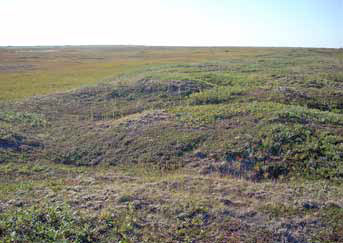
Joanne Goodsell
The main social challenge for managing wilderness areas in northwest Alaska lies in balancing federal and non-local priorities with local priorities and norms. Management of them must be generally compatible with local traditions in order for local people to support their existence, and to reduce cross-cultural conflicts. Unfortunately, there is a fundamental difference between the core of wilderness management that defines “natural and healthy wildlife populations” as being not unduly influenced by humans, and the local perspective that Indigenous people have been affecting wildlife populations through their hunting for millennia and thus are a natural part of the system. It is impossible for local people to subscribe to the theory that natural wildlife populations are only those not manipulated by humans, when set against the thousands of years of local wildlife populations coexisting with a subsistence culture. When can the presence of humans be natural? It’s when wild populations have evolved with their presence and influence over thousands of years, that’s when. For those that are skeptical of the ecological benefit of a hunting culture that has evolved with a landscape and its wildlife populations, it would serve well to remember the attitudes of people as it related to wolves in places like the Yellowstone National Park ecosystem. At one time, not that long ago, predators where seen as only detrimental to ecosystems and their removal was believed to be what was in the best interest of the nation’s treasured wild areas, like Yellowstone.
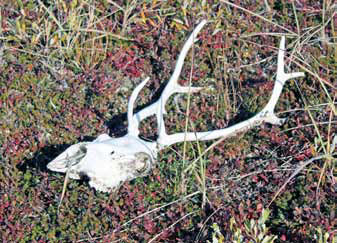
Alex Whiting
However, it is now well known that this understanding of ecosystems was incorrect and that predators are necessary to a healthy ecosystem. While conservation in the form of regulating human take for long-term sustainability is important, the Yellowstone example proves consumptive use of wildlife populations (within limits) promotes a healthier and more resilient ecosystem than would occur if these populations were not harvested at all, or minimally. While it is not always obvious to the casual observer, there are other ecological benefits besides the predator-prey relationship that humans have contributed to the Arctic systems.
One of the clearest examples being that some of the most productive habitats on the Arctic tundra are the numerous old house pits (Figure 8) where more varied and productive plant species are found providing quality forage for herbivores and where raptors, foxes, rodents, and ermine find denning and hunting sites. In addition, even the smaller but more numerous butchering sites spread over the entire region provide essential nutrients for the plants and scavengers found in those locations (Figure 9). Human presence can be beneficial to wild systems, especially where coevolution over centuries has occurred.

Jim Dau
Having a people with ties going back thousands of years continue consumptive use of wilderness areas should not be something that is merely “tolerated” or “allowed,” but instead should be part and parcel with the celebration of these areas as national treasures. Supporting the continuation of America’s Indigenous Arctic populations as a managing philosophy should be equal to all other management considerations of these wilderness areas and the other federal lands in northwest Alaska. Unfortunately, the attitude of many western managers, bureaucrats, and wilderness advocates continues to be one of not fully committing to the belief that the human presence in northwest Alaska is a natural part of the ecology. Due to this cultural dichotomy, federal and nongovernmental organizations are many times at odds with local standards, uses, and philosophies.
Policies that are meant to protect designated wilderness areas from small scale human use impacts (including consumptive use), while likely consistent with the Wilderness Act, are generally incompatible with local perspectives and needs. Even though management of the northwest Alaska wilderness areas is not always agreeable with the local culture, the protected habitat found in these areas is critical to the resilience of the local ecosystem and the culture that depends on it. Their fates are inextricable. Many threats remain for both; some of the more notable include climate change, long-range contaminants, predator-prey balances, and insect and zoonotic outbreaks. Additionally, recent proposals to build road systems to the mineral resources in northwest Alaska and the mines that would be developed pose real challenges to the long-term ecological integrity of this region.
The wild matrix of intact wilderness (Figure 10) that still exists inside and outside of designated wilderness areas, from the Chukchi Sea to the Canadian border, may partly ameliorate the negative effects of these impacts to the land and animals. Whether in the end it will be enough to enable both the Indigenous cultures and the wilderness areas to survive and prosper remains to be seen.
References
Whiting, A. 2004.
The Relationship between Qikiktagrugmiut (Kotzebue Tribal Members) and the Western Arctic Parklands, Alaska, United States. International Journal of Wilderness 10(2):22-31, 8
Part of a series of articles titled Alaska Park Science - Volume 13 Issue 1: Wilderness in Alaska.
Last updated: October 30, 2021
